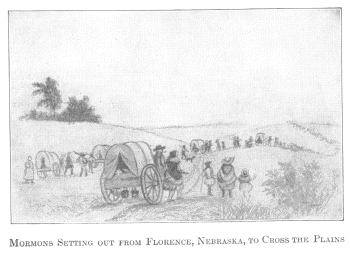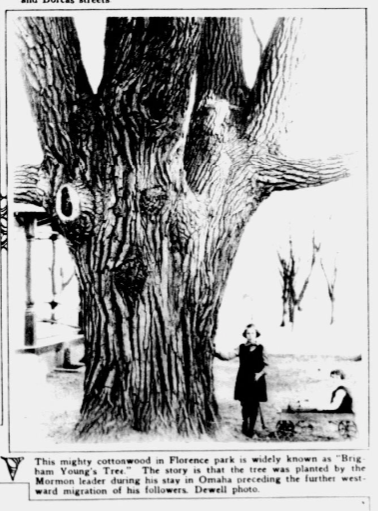In 1846, a town emerged on the western bank of the Missouri River. Although it only existed for a few years, there were a lot of elements that resembled a regular town, and its impact is still felt today. This is a history of Winter Quarters in the Indian Country.

Terrorized by religious extremists in the eastern United States, including New York and Illinois, members of The Church of Jesus Christ of Latter-day Saints took up their lives and journeyed westward across North America, following their leaders. Eventually they received word of an area at the edge of a great sea, and thousands packed wagons, pulled handcarts, bought ox, and headed west towards the future Salt Lake City. Moving along as a large unit, their route would take them through present-day North Omaha.
Arriving at Kanesville, Iowa in spring 1846, the Mormon travelers quickly got in touch with the local US government Indian agent to find out whether they could stay in the Indian Territory across the Missouri River. Within days they secured a meeting with representatives from the Omaha and Winnebago tribes, who gave them permission to stay near the river on the west side of the river.

However, many of the travelers must have heard the negotiations wrong, because their leader guided them about three miles west of the river along present-day Mormon Bridge Road. Establishing their temporary township near present-day State Street, the group named it Cutler’s Park in honor of the leader who brought them to that site. However, within a month, the entire encampment of nearly 4,000 people were moving east back towards the river. Apparently the tribes complained that the group was setup in a prime hunting valley, and not by the river where they’d agreed to their positioning.

When they got to the river, church members quickly built up Winter Quarters. Winter Quarters had a mayor and city council, 24 policemen and fireguards, various administrative committees, and a town square for public meetings. There were more than a thousand cabins, houses, soddies, and dugouts built onto square blocks with yards and streets. There were sidewalks and intersections, and the entire temporary town was established as a regular community.
When The Church of Jesus Christ of Latter-day Saints pioneers established Winter Quarters in present-day Florence in 1846, there were reportedly several Black people among them. Listed as “colored servants” because the church informally did not allow Black members, the group included Hark Lay Wales (1825–1881), Oscar Crosby (c.1815-c.1872), Green Flake (1828-1903), and Jane Manning James (1813–1908). Each of these pioneers left an indelible mark that should still resonate today.
Unfortunately, many of the Mormons weren’t ready for a cold, harsh winter on the banks of the river. Between disease, starvation and scurvy, hundreds of people died. A total of 359 travelers were buried in present-day Florence’s Mormon Pioneer Cemetery.

When spring broke open, almost all of the Mormons packed up and left town. A few were left though, and they left their buildings behind. Houses, stores, grain storage, and a few other buildings stood there for years, some in use, many vacant. The last remnant standing today is the Florence Mill, located where Mill Creek once flowed freely to the Missouri River. For reference, the mill was located on the west side of Winter Quarters.

In 1850, early Nebraska pioneer Peter Sarpy told James C. Mitchell about the deserted Winter Quarters across the river from Kanesville, Iowa. By 1854, Mitchell eventually bought up all the land and renamed it for his wife’s niece.
Winter Quarters Tour
Today, there are several monuments, memorials, and other commemorations to the Latter Day Saints who traveled to Winter Quarters and beyond in the Florence area. They include:
- Winter Quarters Temple, 8283 North 34th Street
- Mormon Trail Center at Historic Winter Quarters, 3215 State Street
- Mormon Pioneer Memorial Bridge, I-680 and the Missouri River
- Site of the Mormon Tree, Florence Park, 3105 State Street
- Florence Mill, 9102 North 30th Street
- Mormon Pioneer Cemetery, 3301 State Street
- Cutler’s Park, Mormon Bridge Road and Young Street
- First Mormon pioneer camp after leaving Winter Quarters, North 69th and Bennington Road
You Might Like…
MY ARTICLES ABOUT THE HISTORY OF FLORENCE
Public Places: Florence Main Street | Florence Ferry | Florence High School | The Mormon Tree | Florence Water Works | Mormon Bridge | Florence Boulevard | River Drive | J.J. Pershing Drive and Monument | Potter’s Field
Businesses: Bank of Florence | Florence Mill | Zesto
Houses: Parker Mansion | Brandeis Country Home | Lantry-Thompson Mansion | Mitchell House | Hunt Mansion
Other Historic Places: Cutler’s Park | Winter Quarters | Vennelyst Park | Florence Depot | Florence Home | Florence Building
People: James M. Parker | James Comey Mitchell | Florence Kilborn | Jacob Weber Sr.
Neighborhoods: Winter Quarters | Florence Field | Wyman Heights | High Point
Other: Directory of Florence Historic Places
Bonus Pics





This is the Mormon Tree, once located in Florence Park. The park, which acted as the Florence town square for generations, was created there because of the story that Brigham Young planted this tree there outside his cabin. Learn more in my article about it »


Click on the pics for info about the Mormon Pioneer Camp.






Leave a comment